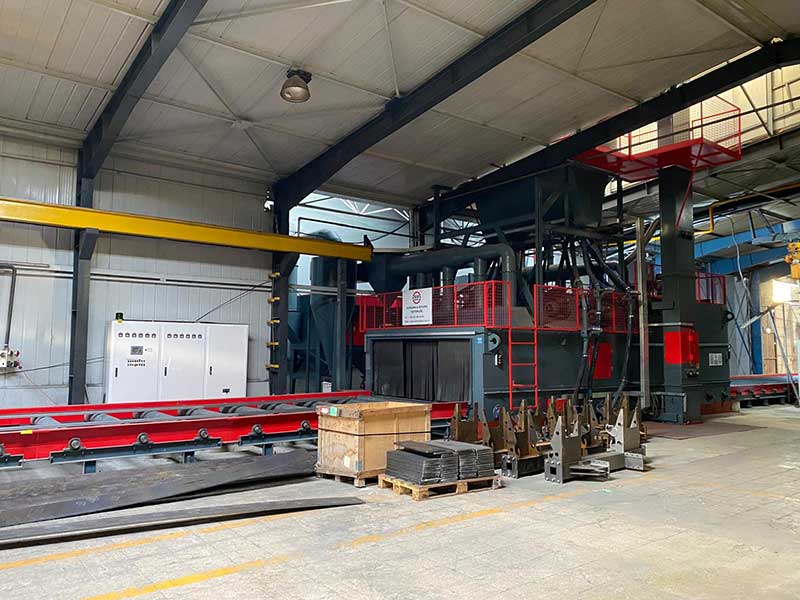
Continuous belt blasting machines are efficient and reliable equipment designed to meet the needs of continuous and high-volume sandblasting in industrial production lines. These machines enable continuous sandblasting, especially of small and medium-sized parts, on mass production lines, significantly increasing production efficiency.
Working Principle:
Continuous belt blasting machines are based on a principle in which parts are continuously transported to the blasting cabinet through a conveyor belt system and brought into contact with abrasive materials that are sprayed at high speed. The belt passes the parts through the sandblasting cabinet, while abrasives sprayed through turbines or nozzles clean, roughen or prepare the surface of the parts. This process continues uninterrupted from the entry and exit of the parts into the blasting cabinet, thus ensuring a continuous production flow.
Basic Components of Continuous Belt Sandblasting Machines:
- Conveyor Belt System:
- It is the mechanism that ensures that the parts are continuously transported to the sandblasting cabinet. They are usually made of wear-resistant materials.
- Sandblasting Cabinet:
- It is the enclosed area where abrasive materials are sprayed and parts are sandblasted.
- Abrasive Blasting System:
- It consists of turbines or nozzles that spray abrasive materials onto parts at high speed.
- Abrasive Recovery System:
- It is the system that ensures that the abrasive materials used are collected and made ready for reuse.
- Dust Collection System:
- It is a system that minimizes environmental effects by separating dust and other particles formed during the sandblasting process from the air.
- Control System:
- It is an electronic or mechanical control unit that allows the adjustment and monitoring of the operating parameters of the machine (belt speed, spray pressure, etc.).
Operation Steps:
- Parts Loading:
- The parts to be processed are loaded into the conveyor belt system.
- In-Cab Transport:
- The conveyor belt system transports the parts inside the blast cabinet.
- Sandblasting Process:
- The abrasive blasting system sprays abrasive materials onto parts at high speed. The tape passes the parts through the cabinet, ensuring that all sides are sandblasted evenly.
- Abrasive Recovery:
- The abrasive materials used fall to the floor of the cabinet and are collected by the recovery system and made ready for reuse.
- Dust Collection:
- The dust and particles generated during the sandblasting process are filtered by the dust collection system.
- Parts Unloading:
- After the sandblasting process is complete, the conveyor belt system moves the parts out of the cab.
Uses:
- Automotive Industry:
- Mass production of small automotive parts (screw parts, small cast parts, etc.).
- Metalworking Industry:
- Cleaning and surface preparation of small metal parts (nuts, bolts, small cast parts, etc.).
- Heat Treatment Industry:
- Removal of the oxide layer of small parts that have undergone heat treatment.
- Foundry Industry:
- Deburring of small casting parts.
Advantages:
- High Production Efficiency:
- Continuous flow and automation increase production speed and efficiency.
- Low Labor Costs:
- Automated systems minimize human intervention.
- Consistent Quality:
- Control systems ensure consistent and reproducible blasting results.
- Material Saving:
- Integrated recovery systems optimise the use of abrasive material.
- Machining Small and Medium-sized Parts:
- The belt system provides great convenience in the mass production of small and medium-sized parts.
Continuous belt sandblasting machines are an important technology in industrial production processes that enables small and medium-sized parts to be sandblasted in mass production lines with high efficiency and quality.




